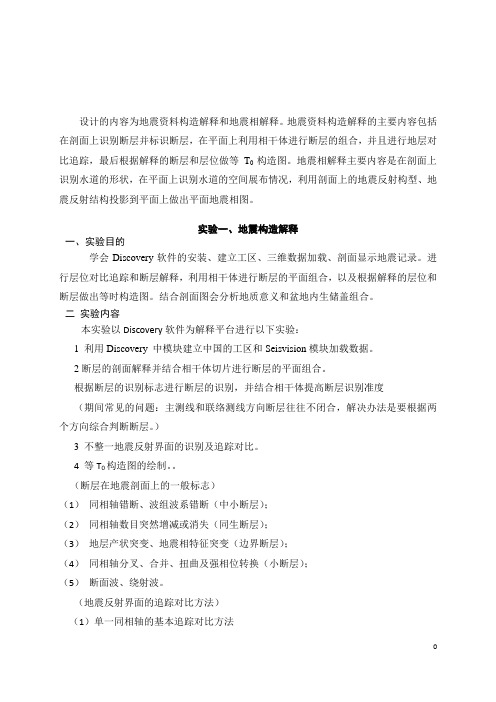地震资料地质解释 第11课地震解释-构造解释 [兼容模式]
11地震资料处理与解释-各种地质现象在时间剖面上的特征

正断 层
断层在时间剖面上的特征及解释
② 逆断层:图2-13是一个逆 断层的二维模拟计算结果 (没有考虑绕射波)。 模型与理论水平叠加剖面存 在差异:断面波偏向下倾方 向,与上盘反射交叉; 下盘受断层牵引,曲率加大, 时间剖面上出现迥转波。
4.断层在偏移剖面上的特征 断盘反射、断面反射波、绕射波、迥转波都已归位,因此确定断 层效果较好。
的 剖 面 上 表 现 明 显 ; 同 样 曲 率
加 斜 凸 起 的 曲 率 大 , 在 水 平 叠
背
背斜和向斜在时间剖面上的特征
2.振幅特征 背斜顶界面反射存在波的发散现象。分配到单位面积上波的 能量会减弱(如图2-3) 界面埋藏越深,凸度越大,射线发散越严重,地震波的振幅 也越小。
背斜和向斜在时间剖面上的特征
正向断层:上下盘倾向与断面倾向一致(a) 反向断层:上下盘倾向一致,但与断面倾向相反(b)
① 正向断层断面波及断盘向下倾方向偏离; ② 反向断层断面波与断盘反射偏移方向相反; ③ 关系现象:
• •
绕射波极小点位置就是断点;
断盘反射波在中断点与绕射波相切,断盘、断面相 对于真实的地层断点、断面向下倾偏离。
断层在时间剖面上的特征及解释
断 面 倾 角 在 测 线 上 的 倾 角 变 化 图
断层在时间剖面上的特征及解释
三、断层在时间剖面上的特征
1.反射标准波发生错断;波组、波 系错断(图2-22)。 2.同相轴数目突然增或减,波组间 隔突变。上升盘地层变薄,下降 盘地层加厚(大断层)。 3.同相轴形状和产状突变,下盘同 相轴零乱或出现空白带(断层的 屏蔽和畸变作用)图2-23。 4.同相轴分叉、合并、扭曲,强相 位转换(小断层的标志) 5.断面波、绕射波,异常波是识别 断层的主要标志。
地震资料解释ppt课件

OUTPUT : SEISMIC FACIES VOLUME
突出不连续数据
*
1600ms相干体切片
1600ms相干体切片
*
相关时窗:1500ms—2800ms
*
小断层典型剖面
横364剖面
横396剖面
从地震剖面上,北部断层断距较小,与北界断层未搭接。
*
精细构造描述技术--相干技术应用实例
立体显示
层拉平技术
瞬时振幅剖面
波阻抗剖面
吸收系数
识别火成岩
火成岩油气藏评价
*
4、砂砾岩体油气藏
地震属性分析技术
约束反演技术
立体显示技术
时频分析技术
砂砾岩体油气藏 评价
*
5、潜山油气藏
储集层特征 研究及有利 相带预测
风化壳储集层预测
潜山内幕储集层特征描述
地震反演技术
吸收系数技术
分形技术
多参数分析技术
*
6、落实圈闭
层 g1构造圈闭图
G1ab井过井地震剖面
G1a井过井地震剖面
T1
T1
T1
T1
T1
南
北
西
东
地震解释基本步骤
*
标定识别储层特征
X33
沙三中底
沙三上底界
夏33井单井相地震相分析
沙三下
沙三中
沙三上
双丰砂体
盘河砂体
Ⅴ
Ⅲ
Ⅳ
Ⅰ
Ⅱ
夏33井单井相分析
平原相
前缘相
前缘相
前缘相
岩性解释
*
沙
三
下
沙 三 下
井旁道与VSPlog 对比
地震资料的构造解释培训

四、地震反射层位和断层的地质解释
(一)、地震解释系统的软、硬件 1、软件
目前常用的两大解释系统 GeoFrame、LandMark、Geoeast(东方物 探),他们基于Solaris(工作站版)或Linix(微机版)操作系统。
解释系统的主要功能是用于煤田、油田的构造解释。如:二维、三维资料 解释。
采区煤巷在切 片上的显示
8煤的煤巷,埋深约 400m,两巷道相距 120m,巷道断面大约 3.2×3.4m。
二、 地震波速度资料解释与应用
• 影响地震波速度的因素
• 1.岩性 • 2.密度 • 3.地层时代 • 4.埋藏深度 • 5.孔隙度与裂隙
影响地震波速度的因素与分布规律
速度资料在地震解释中应用概括起来有以下几方面:
2-10m范围内。
IV. 煤层的物性及其反射
1) 煤层及其围岩的物性
物性
第四系 煤层的围岩
(砂岩、粉砂岩、泥岩)
煤层
密度,g/cm3 1.8-2.0 2.4-2.6 1.3-1.4
纵波速度,m/s 1500-1800 3100-3500 1900-2400
在煤系中,煤层是一个低速、低密度的夹层
2) 煤层的顶底界面都是强反射面
VII. 煤层内、煤层间多次发育
2、煤层反射波
• 煤层反射波是与主要可采煤层有关、主要由煤层顶底板同类反射波叠加, 也包括层内多次及有关转换波和邻近煤层的相对弱反射叠加而成的复合波。
由于煤层的岩性、厚度多半横向稳定,对应的反射波也是一个横向稳定、连 续性好的反射波。通常煤层反射波为底板反射。
煤层反射波形成机制的特点,提高了煤炭地震勘探解决地质问题、完成地质 任务的能力和效果。
进行时-深转换、绘制地质剖面和等高线图 根据速度资料识别波的性质,如多次波、绕射波和声波等。 利用速度资料制作合成地震记录和理论地震模型,对地震记录作层位解释。 利用速度纵横向变化规律,研究地层沉积特征和相态展布。 利用层速度资料,预测岩性分布和砂泥岩横向变化。 利用速度资料预测地层异常压力。
2020学年高中地理第11课时地质灾害及其防避讲义鲁教版必修1(2021-2022学年)

第十一课时地质灾害及其防避(原教材选修5第二单元第一节、第四单元)学习目标:1.识记主要的地质灾害类型及特点。
(重点)2。
掌握地震、滑坡和泥石流等地质灾害的成因及防避措施。
(重难点)一、地震灾害1.概念(1)震源:引起地震的能量释放的源头。
(2)震源深度:震源垂直向上到地表的距离。
(3)震中:震源上方正对着的地面。
(4)震中距:震中到周围地面上某一点的距离。
(5)等震线:在地图上把地面破坏程度相似的各点连成的曲线。
2.衡量指标(1)震级①含义:衡量地震释放能量大小。
②特点:一次地震只有一个震级。
震级越高,释放的能量越大。
(2)烈度①含义:衡量地震发生时地面受到影响和破坏程度.②特点:烈度越大,破坏越严重;一次地震可有多个烈度。
③影响因素:震级、震源深度、地质构造、地面建筑等。
3.地震类型(1)按震源深度划分为:浅源地震、中源地震和深源地震。
(2)按成因机制划分为:构造地震、陷落地震和人工诱发地震。
(世界上发生的地震大部分属于构造地震)4.发生机制错误!―→错误!―→错误!―→错误!ﻬ5.主要危害(1)造成房屋倒塌,破坏道路、管道、通信等基础设施。
(2)导致人员伤亡和财产损失.(3)诱发崩塌、滑坡、泥石流、火灾、海啸、有毒气体泄漏、疫病蔓延等灾害。
(4)破坏当地的资源环境和生态系统,严重损害灾区人们的心理健康。
6.分布(1)世界错误!未定义书签。
(2)中国①特点:范围广、频度高、强度大、灾情严重。
②频发地区:台湾以及西南、西北和华北的活动构造带上.7.防避措施(1)社会层面:①加强地震监测体系建设,地震预报科技攻关、防震避灾制度建设及执行情况智查。
②做好地震应急方案制定及组织实施等.③加强防震避灾教育,提高公民防震避震意识及能力.(2)个人层面:①了解生活所在地的地震风险等级、居住房屋的结构和防震性能.②地震发生时,需要根据自己所处环境,迅速采取有效保护及科学自救措施.③地震后要注意预防和避免次生灾害的影响.二、滑坡和泥石流灾害1.概念(1)滑坡:斜坡上的岩体或土体在重力作用下沿一定的软弱面(或软弱带)整体向下滑动的现象。
地震资料解释

沿横轴方向上均匀分布的每条小细线上的波形代表共中心点处叠加道记录,从浅到深有一系列的波组。剖面最左端的第1道代表满叠加次数的第1个共中心点叠加道记录。最右端的道代表满叠加次数的最后一个共中心点叠加道记录。剖面上总共显示多少个叠加道记录就说明有多少个CDP点。所以在剖面时间线零线上边标有CDP序号,而且还标有桩号。
6.沿测线闭合圈对比(剖面的闭合)
剖面间的闭合不能用二维偏移剖面,只有利用三维地震资料,才能使其闭合。
7.利用偏移剖面进行对比
剖面间的对比:有助于对剖面作地质解释和作构造图等工作。
利用地质规律进行对比 在一个工区内,地质构造特征及地质结构都遵循一定的地质规律,它们必然反映在时间剖面上,抓住其规律对剖面的对比解释有好处。这需要解释人员有较强的地质理论基础和经验。
角度不整合:在0.5s左右存在角度不整合
(二)、超复和退复
超复和退复发育于盆地边缘的斜坡带,也是不整合的一种表现形式。 1.超复 在海侵时,地层沉积范围不断扩大,盆地边缘地带的新地层会依次超越覆盖在下面较老地层之上。在时间剖面上表现为几组反射波互不平行,逐渐靠拢,在超复点处出现同相轴的分叉、合并现象。超复不整合面上的地层反射波相位,依次被下部地层反射波所代替。 2.退复 当海退时,沉积物分布范围逐渐减小,上覆新地层沉积范围不断向盆地中心退缩。在时间剖面上,上覆新地层的反射波逐步被下面老地层的反射波所替代。
(一)、不整合
不整合是地壳运动引起的沉积间断。它对油、气的聚集有密切关系,对地震地层学的研究也有重要意义,不整合分为平行不整合与角度不整合两种。 1.平行不整合(假整合) 老地层主要受上升运动影响,呈水平状态出露地表,遭受较长时期的外力作用破坏之后,又受下降运动影响而沉降,继续接受新的沉积,因而新老地层产状一致,其间存在侵蚀面,这种现象称之为平行不整合。平行不整合在时间剖面上不容易识别,但不整合面受到剥蚀而凸凹不平,往往产生绕射波,并且由于波阻抗差变化大,使不整合面上的反射波振幅和波形变化也较大,因此可以根据这些特点去辨认平行不整合。
地震解释知识点

地震解释知识点地震是指地球地壳中发生的震动现象。
它是地壳中岩石断裂和移动的结果,通常由地壳板块运动引起。
地震是地球表面最常见的自然灾害之一,给人们的生活和财产带来了严重的威胁。
在本文中,我们将逐步解释地震的知识点。
1.地震的原因:地球的外部是由数块巨大的板块组成的,它们以极慢的速度相互推动、拉开、挤压。
当板块运动过程中积累了足够的能量时,就会发生地震。
这种能量释放的结果是地震波,它们沿着地球内部传播,并在地表造成震动。
2.地震的震中和震源:地震的震中是指离地震发生地点最近的地表点,也是人们感受到地震最强烈的地方。
而震源是指地震发生的具体地点在地球内部的位置。
震源的深度不同,地震的影响程度也会有所不同。
3.地震的震级和震源深度:地震的震级是用来表示地震能量大小的指标。
常用的震级有里氏震级和黄氏震级。
里氏震级是由震波振幅和震源距离计算而得,而黄氏震级是根据地震破坏程度和震感的调查得到的。
此外,地震的震源深度也会影响地震的破坏程度。
一般来说,震源越深,地震的破坏程度越小。
4.地震的破坏:地震会对人类的生活和财产造成严重破坏。
地震的破坏主要来自于地震波的震动和地壳的断裂、滑动。
地震波的震动可以引起建筑物的倒塌、桥梁的破坏等。
地壳的断裂、滑动会导致地表的隆起或下沉,从而造成地表的破坏和地震后的次生灾害。
5.地震的预测和防范:地震的预测和防范是减轻地震灾害的重要手段。
目前,地震的预测主要依靠地震学家对地震活动规律的研究和地震监测网络的建设。
预测地震的时间和地点仍然是一个难题。
而地震的防范主要包括建造抗震建筑、制定地震防灾预案等措施。
6.地震的影响:地震不仅对人类的生活和财产造成了巨大的影响,还对地球的地貌和地质结构产生了重要的影响。
地震通过地壳的运动和断裂,改变了地球表面的地形,形成了山脉、峡谷等地貌特征。
同时,地震还导致了地球内部物质的运动和重新分布,影响了地球的地质结构。
总结:地震是地球地壳中岩石断裂和移动的结果,形成的地震波会在地球内部传播,并在地表造成震动。
第10课地震解释-构造解释

断块披覆构造是受断裂活动控制,根据基岩断块的 形态特征可单断式、断阶式和地垒式披覆构造。不整 合面以下基岩断块具有倾斜地层中断层的反射特征。
不整合面
古背斜披覆构造位于古背斜之上
3 地震构造解释
3.1 3.2 3.3 3.4 3.5
概述 复杂构造形态的特殊地震响应 断层解释 典型构造样式的地震识别 构造活动时期分析方法
披覆褶皱的实例
3.5 构造活动时期分析方法
3.5.1 3.5.2 3.5.3 3.5.4
基本概念 不整合面分析和构造层分析 褶皱相关的生长地层分析 断层相关的生长地层分析
课堂练习:复杂构造下的断层及层序解释Leabharlann 2)底辟构造的结构
底辟构造由底辟核和核上变形岩层两部分所组成; 底辟核指发生了塑性流动变形的那部分地层;通常为盐 岩、膏盐岩、泥岩和火山侵入岩等; 核上变形岩层指底辟核之上的因底辟核的侵入而发生了 构造形变的非塑性岩层。
核 上 岩 层 底辟核 核下岩层
3)底辟核常见的内部结构特征有: ①均匀结构,表现为弱反射特征(下部) ②搅混结构,表现为杂乱反射特征(上部) ③与围岩常具有指状交互的关系
地震资料解释基础
第10课
王英民 2010年
3.4 典型构造样式的地震识别
3.4.1 构造样式的概念与意义 3.4.2 水平伸展构造 3.4.3 水平收缩构造 3.4.4 水平走滑构造 3.4.5 垂直升降构造
3.4.5 垂直升降构造
(1)垂直升降构造的主要构造样式 (2)底辟构造的识别 (3)披覆构造的识别
盐枕构造
伸展带
伸展带 中性面 挤压带
底辟构造与断层滑脱褶皱的比较
②因剪切力使底辟核侧翼的地层发生牵引。
地震相解释和构造解释

设计的内容为地震资料构造解释和地震相解释。
地震资料构造解释的主要内容包括在剖面上识别断层并标识断层,在平面上利用相干体进行断层的组合,并且进行地层对比追踪,最后根据解释的断层和层位做等T0构造图。
地震相解释主要内容是在剖面上识别水道的形状,在平面上识别水道的空间展布情况,利用剖面上的地震反射构型、地震反射结构投影到平面上做出平面地震相图。
实验一、地震构造解释一、实验目的学会Discovery软件的安装、建立工区、三维数据加载、剖面显示地震记录。
进行层位对比追踪和断层解释,利用相干体进行断层的平面组合,以及根据解释的层位和断层做出等时构造图。
结合剖面图会分析地质意义和盆地内生储盖组合。
二实验内容本实验以Discovery软件为解释平台进行以下实验:1 利用Discovery 中模块建立中国的工区和Seisvision模块加载数据。
2断层的剖面解释并结合相干体切片进行断层的平面组合。
根据断层的识别标志进行断层的识别,并结合相干体提高断层识别准度(期间常见的问题:主测线和联络测线方向断层往往不闭合,解决办法是要根据两个方向综合判断断层。
)3 不整一地震反射界面的识别及追踪对比。
4 等T0构造图的绘制。
(断层在地震剖面上的一般标志)(1)同相轴错断、波组波系错断(中小断层);(2)同相轴数目突然增减或消失(同生断层);(3)地层产状突变、地震相特征突变(边界断层);(4)同相轴分叉、合并、扭曲及强相位转换(小断层);(5)断面波、绕射波。
(地震反射界面的追踪对比方法)(1)单一同相轴的基本追踪对比方法★反射波同相轴具线状廷伸特征,相邻记录道的同一同相轴应为一连续的曲线,相邻界面的同相轴应大体平行。
★相邻记录道同一界面反射波同相轴波形特征相似,即振幅、周期、相位数等相似,它们在空间上是逐渐地变化的。
(2)根据波组或波系进行地震反射界面对比★波组是相邻若干个界面形成的多个强反射同相轴的组合。
波组之间是一些振幅比较弱的同相轴,★多个波组组成一个波系。
地震资料处理与解释-地震构造图的绘制及地质解释

由等t0图经过空间校正作真深度构造图
2)求水平偏移距离和真深度H
• •
均匀介质情况下: OO′ = h 0 sin ϕ h = h 0 cos ϕ 连续介质情况下: OO′ = R 0 ⋅ sin ϕ h = Z 0 + R 0 sin ϕ
均匀介质
连续介质
由等t0图经过空间校正作真深度构造图 3) 空间校正数据表的制作
地震构造图
查明地下地质体构造形态的变化,要把剖面和平面结 合起来进行空间解释,基本成果就是地震反射层构造图。
一、地震构造图及种类
1.什么是构造图
用等值线(等深线或等时线)及地质符号(断层、尖灭 超复等)直观地表示地下某一层的地质构造特征的一种平 面图件。
是地震勘探最终图件,是为钻探提供井位的主要依据。
上、下盘产状有关。 正断层,上、下盘断层线间错开,出现空白; 逆断层,上下两盘断层线间等深线出现叠掩;
构造图制作步骤
超复、尖灭等地质现象在构造图都表现为标准层向某方向的缺失。 可用多层构造图的闭合来判断地层间的关系,如下图,可明显看出 两个界面之间为角度不整合关系,且第二层往北不整合尖灭。
构造图制作步骤
构造图制作步骤 6.勾绘等值线
按规定线距(根据t0或h值),勾圆滑曲线;原则:从简单到复杂,由底到高 ,先勾出大致轮廓(如构造高、低点),再绘构造细节,复杂时以断块为单 位绘制。
注意:
•
1)平面图所表示的构造特征应与剖面图一致,如构造形态、范围、 高点位置、幅度、构造间的相互关系等应符合。 2)勾绘构造等值线应符合构造规律: ① 单斜层时,不 允许多线、缺线 (右图)。
地震构造图
二、构造图的绘制
地震资料解释

面 波
t
的延续时间为Δt,穿越岩层的
往返时间为Δτ。
岩层较厚,Δτ>Δt,同一接
t 收点收到的来自界面R1和R2的两个反
射面也可以分开。形成两个单波。保
留着各自的波形特征。这种情况,一
般较少。
岩层较厚,二个反射波可以分开
2023/11/5
10
1 地震记录的形成
岩层较薄时, Δτ<Δt,
来自相距很近的各个反射界面
50
2023年11月5日12
51
时14分
4 三维数据体
三维地震采集得到空间采样很密集的数据,经处理 后得到3D地震数据体。 3D数据体里是正交排列的 数据点,在同一方向上的数据点间隔是相等的。利 用3D数据体可得到供解释的剖面或切片:
纵(主)测线垂直剖面
横(联络)测线垂直剖面
水平时间(或深度)切片
2023/11/5
47
3 水平切片
2023/11/5
水平切片上 的时间
倾角增大 同向轴变窄
频率增高 同向轴变窄
3D水平切片
48
3 水平切片
2 水平切片上反射同相轴走向与界面走向一致
2023/11/5
地 层 走 向
49
3 水平切片
3 水平切片与垂直地震剖面反射同相轴交线闭合
2023/11/5
第七章 地震勘探资料解释
2023/11/5
3
2023/11/5
4
地震资料解释
地震资料解释分类:
把采集和处理后的资料转化成抽象的地质术语,即确定构造形态空间位置, 推测地层的岩性、厚度、层间接触关系,确定地层含油气的可能性,为钻 探提供准确井位。
构造解释:利用反射波旅行时,速度等信息,查明地下地层构造形态、埋 深、接触关系
地震资料解释详解课件

目录
• 地震资料解释概述 • 地震资料的基础知识 • 地震资料解释的方法与技术 • 地震资料在油气勘探中的应用 • 地震资料解释的挑战与未来发展 • 案例分析与实践操作
01
地震资料解释概述
定义与目的
定义
地震资料解释是对地震勘探所得的原始数据进行处理、分析、解释和推断的过 程,目的是揭示地下岩层的结构和性质,为地质勘探和资源开发提供依据。
地震波的传播路径
地震波在地下传播时,会遇到不同介质分界面, 波的传播方向会发生反射、折射或散射。
地震波的衰减
地震波在传播过程中,由于介质吸收、散射等原 因,能量会逐渐衰减。
地震波的种类与特性
体波与面波
体波在地下传播,面波则沿地表传播。体波包括纵波和横 波,面波则分为长周期和短周期两种。
反射波与折射波
总结词
基于地震地层学的原理和方法,对地震资料进行解释和分析的方法。
详细描述
地震地层学解释方法主要依据地震地层学的原理和方法,通过分析地震剖面中地层的连续性、接触关系、沉积旋 回等信息,推断地层的沉积环境、沉积相和沉积历史。这种方法在石油、天然气勘探和煤田勘探等领域应用广泛 。
地震岩性学解释方法
总结词
软件操作流程
详细介绍地震资料解释软件的操 作流程,包括数据导入、处理、 解释等方面的步骤和技巧。
软件操作演示
通过实际操作演示,展示如何使 用地震资料解释软件进行数据分 析和解释,包括界面布局、工具 使用等方面的演示。
实践操作:地震资料解释练习题
练习题目的选取
选取具有代表性的地震资料解释练习题目,包括二维和三维地震数 据,涉及不同的地质体和地质现象。
地震资料解释存在多解性,即同一组地震数据可能对应多种地质解释。
地震资料解释基础(王英民)第11课——地震相分析

(3)地震相编图中要注意的问题
2)不同采集、处理条件资料的应用问题
当采集、处理条件不同时,地震相特征会有很大不同,尤其
表现在对地震反射结构的影响上。而地震反射构型和地震相单元
外形因为是几何地震学信息,故对采集、处理条件不太敏感。 解决办法: ①尽可能使用采集、处理条件相同的资料。 ②只利用其地震反射构型和地震相单元外形等几何地震学信
息。
(3)地震相编图中要注意的问题
3) 前积构型的表示方法 前积构型是所有地震反射构型中最为重要的一类构造, 它可以反映沉积体的性质、古水流方向及沉积---沉降之间的补 偿状况。因此在编制地震相平面图时,应当尽可能对前积构型
的类型加以细致划分,并且将各剖面上前积构型的推进方向投
影到平面图上。 当前积构型表现为多期推进的特点时,应尽可能将各推 进期划分开,并在图上加以注明。在有条件情况下,应计算储 前积层的视倾角并标注在平面图上。
弱振幅断续 反射区
中振幅亚平 行反射
高振幅平行 连续反射
杂乱前积 反射
杂乱无序 反射
4.3.2 地震相的沉积相解释
(1)地震相与沉积相之间的联系和区别
1)地震相是沉积相某些特殊物质表现的物理响应 沉积相是一定沉积环境的产物,而岩相、生物相、化学相是 沉积相的不同物质表现。
测井相本质上是岩相的一种物理响应。
地震相与测井相有某种相似之处,它也是对沉积相的某种 物质表现的物理响应。但这种物质表现是某种在传统的沉积相研 究中基本上没有加以利用和考虑的新的物质表现——这就是沉积 体的外形、岩层的叠置模式以及岩性差异的组合方式(它们分别与 地震相单元的外形、地震反射构型和地震反射结构相对应)。
4.3.2 地震相的沉积相解释
体系域)内部,根据地震相标志划分出不同的
地震资料解释

有瘦,难以闭合对比。这时作频率分析和统计,找出全区的通频带
一致部分。进行反褶积或带通滤波,使频率保持ห้องสมุดไป่ตู้致。第三步是调查
地震剖面上的振幅、能量是否一致。首先作振幅统计;可以看出最
高、最低、平均振幅。如果振幅不一致,进行振幅均衡处理可以使振
幅保持一致。
地震资料解释
二维解释
2、闭合差校正 二维资料普遍存在闭合差,因此除了上述各种之
地震资料解释
二维解释
1、 相 位 校 正 及 波 形 、 振 幅 、 频 率 一 致 性 处 理 二 维 资 料 由 于 施 工 年 度 、 队 别 、 施 工 因 素 及 处 理 流 程 不 统 一 , 所
以 时 间 剖 面 相 位 不 一 致 、 波 形 不 一 致 、 频 率 及 能 量 也 不 一 致 。
地震资料解释
二维解释
(一)、准备工作 1、野外, 了解野外工作方法、施工因素、井深、药量、基准面、 排列长度、组合个数…。(涉及到处理方法、解释精度) 2 、处理 ,了解处理的主要流程及处理效果。保幅、修饰和去噪手 段。 3 、钻井 ,收集钻井资料及钻井报告。 4 、地质 ,收集已有的邻区的地质、地震资料及成果报告。 另外,还要了解目的层埋深、岩性、储集性,明确生储盖组合及 凹陷的构造格局、储层分布状况。如塔里木东河砂岩,岩性变化、 尖灭,华北地区找沙河街组的沙1、沙2、沙3段,小断块等。
地震资料的构造解释

• 断层一般分正断层、逆断层
1. 断层的性质
拉张式构造模式-正断层 挤压式构造模式-逆断层
2. 断层在地震剖面上的基本特征
• 断层构造在地震剖面中的表现特征有:
1. 反射波同相轴错断,但两侧波组关系稳定,波组特 征清楚;
断层反射特征2
✓ 反射同相轴数目突然增减或消失,波组间隔突变。
在断层的下降盘地层 变厚,而上升盘地层 变薄甚至缺失。这种 情况往往在某一盆地 的边界附近,可能为 基底大断裂的反映。 其特点是断距大,延 伸长,破碎带宽。这 种断层对地层厚度起 着控制作用,一般是 划分区域构造单元的 分界线。
断层反射特征2
Depth 3600 3700 3800 3900 4000 4100 4200 4300 4400 4500
Time 2703 2758 2811 2865 2917 2969 3020 3071 3121 3170
简单易行, 精度偏低。
深-时转换/平均速度标定
VSP资料标定
• VSP资料与地震剖面中 的地震信号有相似的初 始波形和传播经历,因 此二者非常相似,标定 效果好。
大断层的断面也是不同介质的分界面,如 果断面比较平缓,可以在地震剖面中产生 明显的断面反射波。
断面波
叠加剖面中:断面波与下降盘反射波斜交,长度变长,倾角变缓;界 面反射、断层面反射、断点绕射等波相互干涉。
断层反射特征5
✓ 异常波(如断面波、绕射波等)的出现。
H166
断面波
大断层的断面也是不同介质的分界面,如 果断面比较平缓,可以在地震剖面中产生 明显的断面反射波。 在叠加资料中,断点绕射波是明显的,在 偏移资料中,绕射波被归位到绕射点,绕 射波一般不明显。
地震知识简介【免费文档】PPT课件

什么是 烈度:地震学上用来衡量地震地面造 成的灾害影响或者破坏程度的一种量度。我
国1980年制定的烈度表分为Ⅰ~XII(1-12)级。
问:地震时,动物都会有ቤተ መጻሕፍቲ ባይዱ些异常
现象?
比较常见的有,井水陡涨陡落、变色 变味、翻花冒泡、温度升降,泉水流 量的突然变化,温泉水温的突然变化, 动物的习性异常,临震前的地声和地 光等。
_______.______.______.
背诵地震谚语:
• 小的闹,大的到,地震一多要报告。 • 先听响,后地动,听到响声快行动。 • 地震没地震,抬头看吊灯。 • 井水是个宝,前兆来得早。 • 电气异常,不能不防。 • 鸡也飞,狗也叫,老鼠机灵先跑掉。 • 灯影一跑,大事不好。 • 房倒树不倒,有树不用跑。 • 地光闪,八成险。 • 上下颠一颠,来回晃半天。 • (房子)酥在颠劲上,倒在晃劲上 • 慢慢晃,慢慢摇,九十里外等着瞧。 • 地震后,雨中行,抬头要看泥石流。 • 破坏往哪找,抬头看房角。
• 1.地震按发生的原因可以分为三种类 型:______._______.________. 2.地震波是地震发生时产生的波动,分______ 和______两种.______比______传播速度快. 3.火山是堆积山的一种类型,由地壳内部岩浆 喷出堆积而成的山体.分____火山,____火 山,____火山三种. 4.火山喷发出来的物质.按物理性质分为
4、 积极互救: 听仔细:要注意倾听被困人员的呼喊、呻
吟、敲击声。
挖的准:要大致确定位置后再抢救,不乱挖。 救得法:先头部、后身体,不强拉硬拖。
1震中距越大,说明该地点与震中的距离越远,所以,震中距 大的地方比震中距小的地方所受的破坏就一定小。(对 错) 2世界上记录到的最大地震是1960年5月22日发生的智 利地震(对 错) 3我过地震较多的省 自治区 直辖市依是台湾 西藏 新疆 四川(对 错) 4我天然地震中,占地震总数90%的地震以上的地震是构 造地震。(对 错) 5某地建房,看见地震台内有很多空地,就可以强行征用过 来使用(对错) 6地光是地壳内喷溢出的气体,强化了低空静电场所致,其 开头有带状 片状 球状 柱状等,颜色已蓝 黄 白居多。(对 错) 7地震应急主要是指在破坏性地震即将发生前和发生后 的短时间内应当采取的各种紧急防灾和抢救措施,它包 括在平时制定地震应急预案以及临震应急和震后应急3 方面(对 错)
- 1、下载文档前请自行甄别文档内容的完整性,平台不提供额外的编辑、内容补充、找答案等附加服务。
- 2、"仅部分预览"的文档,不可在线预览部分如存在完整性等问题,可反馈申请退款(可完整预览的文档不适用该条件!)。
- 3、如文档侵犯您的权益,请联系客服反馈,我们会尽快为您处理(人工客服工作时间:9:00-18:30)。
(3)底辟构造的成因演化及类型
1)拉张条件下的盐底辟演化模式
Reactive diapirsm 在区 域拉张背景下,盐上地层形成 薄弱带和横向负载梯度,盐岩 在差异负载作用下挤入薄弱带 内,上方为阶梯状断块。拉张 作用消失底辟活动即停止
Active diapirism 拉张作 用继续,盐体向上发展,使周 缘断块向外侧倾翘
②因剪切力使底辟核侧翼的地层发生牵引。 ③因底辟核四周的向心流动使塑性岩层的减薄。从而使
上覆地层下陷,形成塌陷构造,并在两个底辟构造之间 形成龟背构造。
④因局部的水平伸展构造变形使核上岩层形成张性断裂。
①因差异挤压使核上岩层形成背斜:使地层在底 辟核顶部明显减薄或局部被剥蚀;强者使地层被 冲断;
泥火山口位于泥火 山丘的上部
(5)潜山披覆构造的识别(drape sructure)
潜山披覆构造:是后期地层披覆在早期的正向构造之上而形成的构造。 与底辟构造相似,可分为下部潜山核和上部变形岩层两部分。它与底辟构造 的重要区别之一在于上下构造变形时期不同,上部地层变形时下部构造不发 生变形,其间为区域不整合。
沉积盆地中常见的底辟构造主要指低密度沉 积岩层盐岩、膏盐岩、泥岩等底辟所形成的构造, 也包括岩浆侵入形成的底辟构造。
2)底辟构造的结构
底辟构造由底辟核和核上变形岩层两部分所组成; 底辟核指发生了塑性流动变形的那部分地层;通常
为盐岩、膏盐岩、泥岩和火山侵入岩等; 核上变形岩层指底辟核之上的因底辟核的侵入而发
sea
横向挤压底辟
(4)盐构造的成因类型及横向组合样式
盐推覆体
增厚盐原 底辟 单斜层
盐筏
假龟背构造 上倾楔
Figure 2. Regional section across the Kwanza Basin. Offshore part is derived from seismic and well data; onshore part is from Hudec and Jackson (2002a). Line location shown in Figures 1 and 3. (a) Vertically exaggerated section. Dashed line connects the top salt elevations on the flanks of the outer Kwanza Basin. Much of the salt in the thickened salt plateau is above this regional datum. Table above the section shows basin subdivisions: top row shows basin types; middle row shows Aptian basin components; bottom row shows structural domains. CB = Caxito block, FT = Funda trough, MB = Mulenvos block, QT = Quenguela trough, BB = Benfica block, PT = Praia trough, LB = Luama block, WT = western trough, NB = Navalha block. Stratigraphic/structural units: 1 = prerift basement, 2 = subsalt sediments (Cuvo Group, shown where observed on seismic), 3 = Aptian salt, 4 = lower Albian, 5 = upper Albian, 6 = Cenomanian–Eocene (Iabe Group), 7 = Oligocene, 8 = lower–middle Miocene (to 11.7 Ma), 9 = upper Miocene (11.7–8.3 Ma), 10 = uppermost Miocene (8.3–5.3 Ma), 11 = Pliocene–Holocene. (b) Same section with no vertical exaggeration.
隐刺穿底辟
刺穿底辟
核 上 岩
层
底辟核 核下岩层
根据核上岩层变形的关系,可以将底辟构造分为隐刺穿底辟构 造和刺穿底辟构造两大类。
隐刺穿底辟构 造:核上地层 有构造变形, 但没有被断开。
刺穿底辟构造: 核上地层被刺 穿而断开,
盐枕构造
非平行褶皱 伸展带
伸展带 中性面 挤压带 平行褶皱
底辟构造与断层滑脱褶皱的比较
Passive diapirism 盐体 进一步向上发育,穿出地层, 盐体上方缺乏沉积物
Allochthonous sheet advance 盐岩供给充足,盐 体溢出地表呈席状扩散
(Hudec and Jackson.2007)
Fig. 14. Seismic examples of salt diapirs. (a) Reactive diapir in the Gulf of Mexico. (b) Formerly passive diapir from the Gulf of Mexico, now buried. Passive emplacement is inferred from the relatively undeformed reflectors abutting the diapir. The original image showed only half of the structure and has been mirrored for consistency with other images in this figure. (c) Formerly active diapir, Lower Congo Basin, Gabon. The active rise is recorded by the arched roof. Onlap of the crestal anticline indicates that uplift has ceased for now. Seismic section courtesy of Total Astrid Marin Gabon and partners. (d) Allochthonous salt sheet, Gulf of Mexico. The feeder has either been pinched off or is not on this line of section.
②因剪切力使底辟核侧翼的地层发生牵引。
30 km
③因底辟核四周的向心流 动使塑性岩层的减薄。从 而使上覆地层下陷,形成 塌陷构造,并在两个底辟构 造之间形成龟背构造。
④因局部的水平 伸展构造变形使 核上岩层形成张 性断裂;
由三角洲推进形成底辟构造的发育模式
1-刺穿盐丘,2-隐刺穿盐背斜,3-残留盐隆,4-掀斜的龟背构 造,初始流出盐向斜,6-边缘向斜,7-正断层
3.4 典型构造样式的地震识别
3.4.1 构造样式的概念与意义 3.4.2 水平伸展构造 3.4.3 水平收缩构造 3.4.4 水平走滑构造 3.4.5 差异升降构造
(1)差异升降构造的主要构造样式
(2)底辟构造的识别
1)基本概念
深部的塑性物质向上运移并使上覆岩层发生 构造变形的作用称为底辟作用(diapirism), 底辟作用形成的构造变形称为底辟构造,又称为 塑性流动构造或挤入构造。
h
h 鸭头状
I 泪滴状
J 箕状
i
5)核上变形岩层的变形样式
塑性的底辟核向上运移对核上岩层施加的构造力相当于 垂直层面的差异挤压力或剪切力,迫使上覆岩层发生围 绕底辟核心的差异升降,并使产生水平方向的伸展。因 此核上地层主要表现为以下变形样式:
①因差异挤压使核上岩层形成背斜:使地层在底辟核顶 部明显减薄或局部被剥蚀;强者使地层被冲断;
2)挤压条件下盐底辟演化模式
横向挤压,底辟上拱使得盐 上地层形成背斜,类似横弯 褶皱变形机理
底辟上覆层侧翼向两侧旋转, 有可能发生剥蚀作用,形成 被动底辟
盐体刺穿上覆层,溢出地表
Fig. 16. Diapir piercement during shortening. This example assumes a preexisting diapir, which is the most common scenario for piercement during shortening. Diapirs may not progress through all of these stages; whether they do depends largely on the magnitude of shortening and the roof thickness above the diapir. (a) Arching of the diapir roof produces outer-arc extension, thinning and weakening the roof. (b) The combination of a weakened roof and salt pressurized by lateral squeezing (displacement loading) initiates active diapirism. Salt breaks through the thinned crest of the anticline, and the roof flaps on either side rotate away from the emerged diapir. (c) Rapid extrusion; salt displaced from the squeezed feeder flows out over the surface to form a salt glacier.
